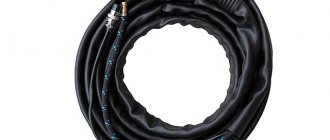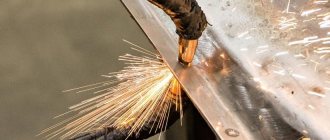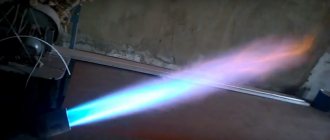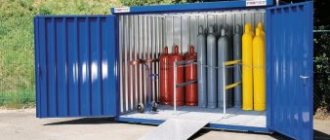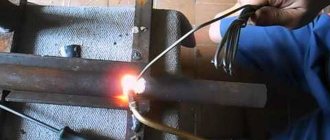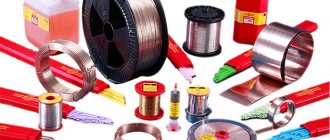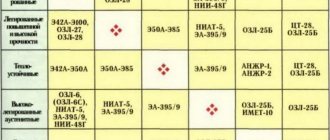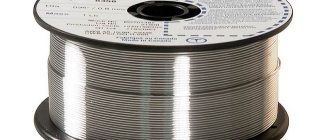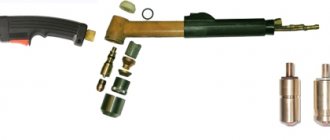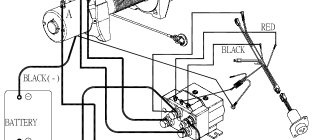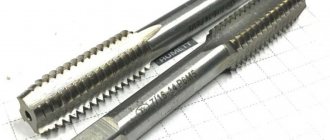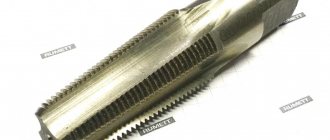1 / 1
For welding metals, the welding torch plays an important role along with the machine itself. The quality of the final result, the safety of the process and the level of productivity directly depend on it.
A semi-automatic torch is usually supplied complete with a welding machine. A good manufacturer immediately selects the best option. But this is a consumable that periodically wears out and requires replacement. Choosing a new one is complicated by a large number of nuances, which can be difficult to understand.
Why do you need a welding torch?
You can do without a torch unless you perform manual arc welding (MMA). In other cases, it is the welder’s main tool. It is used in all types of welding processes where gas is required:
- MIG/MAG (in a protective gas environment);
- TIG (argon arc);
- point method;
- gas welding;
- plasma cutting.
Its main purpose is to mix and supply protective or combustible gas to the working area, forming a stable flame. In this case, the combustion strength can be adjusted.
Understanding the device
Welding torches for each type of welding may have design features unique to them. But in general their device is identical: the burner itself (gander)
,
sleeve (train)
and
contact element
.
The gas welding tool is designed as simply as possible. On the back of the handle there are two fittings to which hoses are connected. The supply of gases is regulated by valves. There is a mixing chamber inside. The tip is attached to the handle by means of a union nut. And the design is completed by a mouthpiece through which the flame comes out.
A torch for a semi-automatic welding machine is distinguished by the fact that in addition to gas, current and welding wire are also supplied to it through a loop. Powerful devices have channels for liquid cooling.
Tool design
A torch for welding with propane gas consists of the following elements:
- lever;
- control valves;
- working chamber with a built-in injector (where the gas mixture is prepared);
- supply hoses connected to the body by means of special nipples;
- replaceable tips (they are installed on each of the hoses).
The hose chambers are marked with information regarding the type of tip and the composition of the gas that moves along this line. The valves on the burner are located in such a way as to make the tool as convenient to use as possible. As a rule, the worker holds it with his right hand and performs the necessary actions with his left.
As for the tip of a standard gas burner, it includes a mouthpiece, an injector and a supply tube. The diameters of the internal cavities of the mouthpiece and injector are designed for the passage of specific gases (propane or oxygen).
The operating temperature in the jet torch zone reaches + 2300 degrees. Therefore, copper is usually used as a material for making mouthpieces. The fact is that copper parts have high thermal conductivity, surpassing their brass counterparts in this regard. This increases their cooling rate during the welding process.
Working principle of a welding torch
This equipment has a simple principle of operation: gases are supplied to the mixer through control valves, after which they exit under pressure through a nozzle. The burning gas flow must have a certain speed - 70-150 m/sec. Exceeding this value causes the flame to break away from the mouthpiece and die out. And if the gas speed is too low, the fire can spread inside the instrument, which can lead to an explosion. Therefore, it is important that combustion occurs in specified modes.
In devices such as MIG/MAG or TIG, the process of seam formation occurs not under the temperature influence of a flame, but through an electric arc. But gas is also present and serves to form a protective environment around the weld pool.
Classification of welding torches
A properly selected welding torch allows you to perform metal welding as efficiently as possible and ensures the comfort and safety of the worker. To buy a tool specifically for your needs, you need to know its classification and design features. The external simplicity of these products is deceptive; If you dig deeper, an unprepared person may feel dizzy from the diversity of their species:
- With and without injector.
- Gas and liquid.
- Universal and specialized.
- Single-flame and multi-flame.
- Manual and machine.
- With different flame power.
In addition, for each type of welding (semi-automatic or manual feed of filler rod, MIG/MAG or TIG, gas welding) a device of a certain design is required. Therefore, before you go shopping, it is useful to familiarize yourself with the classification of equipment.
Gas-burners
According to the principle of operation, torches for gas welding are either injection or non-injector (diffusion), and also differ in the gas used and in power.
Power characteristics
The capabilities of a gas burner and its scope of application largely depend on its power. This indicator is regulated by GOST 1077-79, according to which equipment is divided into 4 types:
- Micropower (r1) – non-injector type burners with a fitting size M12x1.25. Used for welding metal with a thickness of 0.1 to 1 mm, as well as for soldering.
- Low power (r2) – injection and non-injector type burners with replaceable fittings (the most popular tips are sizes M12x1.25 and M16x1.5). This is a common option, well suited for home use and small workshops. The thickness of the welded products is from 0.3 to 10 mm.
- Average power (r3) – here it is also possible to use injection and non-injector mechanisms. Tip size M16x1.5. They cook metal with a thickness of 0.5-35 mm. Most often used in industrial settings.
- High power (r4) – only injection type burners with M16x1.5 fitting. Weld thick-walled structures from 40 to 85 mm.
Injectorless burners
Diffusion models are extremely simple in design. Oxygen and combustible gas are supplied to the mixing chamber with the same pressure through separate channels. Before entering the mixer, the flows are divided into several thin jets. This creates extra swirls and promotes better mixing. The resulting mixture rushes further and comes out of the tip.
Injectorless burners have their advantages: you can separately regulate the supply of each component, accurately changing the flame temperature at the outlet; high pressure is not required for operation. The disadvantages include incomplete combustion of gas and low efficiency, the risk of flame entering the nozzle with subsequent explosion of the holder.
Injection
In injection models, only oxygen pressure can be adjusted. It is fed into the mixing chamber at high speed past the openings for the entry of flammable gas. This creates a rarefied low-pressure zone, under the influence of which the flammable gas rushes into the mixer after the oxygen. And then the mixture comes out along the tip. Thanks to this, the components are mixed thoroughly, and combustion occurs at a higher temperature. The flame escapes from the nozzle at a higher speed, which prevents it from entering. The disadvantage is uneven combustion, due to the fact that it is impossible to accurately adjust the ratio of components.
Differences in gas used
Three different types of gas mixture can be used in the welding process. Each of them requires its own burner:
1. For acetylene welding. The main application is welding, soldering and heating of metals. Flame temperature is about 3200 °C. You can weld ferrous metals of small thickness. Working with high-quality alloy steel is also possible, but the quality will be low.
2. Propane-oxygen. Due to the low combustion temperature of propane (2000-2100 °C), it is difficult to cook ferrous metal with them, but it is possible if the material thickness is up to 3 mm and the quality of the connection does not matter. These torches are better suited for soldering using high-temperature solder.
3. For gas-air propane welding. These are injection-type burners for working with a propane-butane mixture. You won't be able to cook or solder with them. The main purpose is to heat non-metallic and metallic materials. For example, when laying a roof or heating pipes for their subsequent bending. They are divided into single-flame and multi-flame (with several nozzles).
Semi-automatic torches (MIG/MAG)
The MIG/MAG welding process is carried out with a fusible electrode in a shielding gas environment. The torch consists of three main elements: the working part - the gooseneck, the cable and the contact connector, which is used to connect to the welding machine. Wire, gas and electric current are supplied through the hose to the working part. The gander is shaped like a pistol with an activation button.
When choosing a torch for semi-automatic welding, a number of factors should be taken into account: amperage, hose length, type of cooling, ergonomics and ease of maintenance.
With the first parameter, everything is very clear; it is only important to know what maximum current your welding machine is designed for, and choose equipment in accordance with this indicator.
The length of the sleeve is selected based on your own preferences and objectives. Some people believe that an excessively long cable contributes to energy loss, preferring short ones. For others, on the contrary, the length margin is important for greater mobility.
The type of cooling can be air or liquid. The first is suitable for welding with low currents (up to 250 A). With more powerful welding machines, liquid cooling is preferable.
Everyone chooses ergonomics for themselves. It is important that the instrument fits comfortably in your hand and is well balanced.
The main load falls on the working edge of the burner. For ease of maintenance, the tip with nozzle and diffuser are removable. This makes it possible to work with wires of different thicknesses, making them easier to clean or replace.
For argon arc welding (TIG)
Argon welding also takes place in a shielding gas environment, but a refractory electrode is used, and the formation of the seam occurs due to the filler material. There is no need for a device for supplying the electrode; it is fixedly fixed in the center of the nozzle. The factors you should pay attention to when choosing are the same as in the case of a semi-automatic. In addition, there are valve TIG torches that allow you to control the gas supply. It is convenient if the torch for argon arc welding is equipped with a trigger, with which you can activate the gas supply at the required moment.
With or without an injector?
Inside welding torches, gas mixing occurs according to 2 principles. Based on this, they are divided:
- non-injector;
- injection.
The technical characteristics of the devices depend on the method of preparing the mixture. In addition, there is a division according to the type of welding.
Without injector
In non-injector models, gas flows from the cylinders through separate channels into the mixing chamber . On the back of the handle there are sockets for connecting to hoses. Valves of different colors regulate the flow of each component of the mixture separately. With their help, the temperature of the torch changes by changing the ratio of oxygen and combustible gas.
Each stream is divided into thin jets before entering the chamber. This improves the mixing of oxygen and fuel component. This mixing technology allows you to work with low pressure and accurately regulate the temperature.
Disadvantages include the possibility of fire getting inside the nozzle and mixing chamber. As a result, the holder may explode.
With injector
The injector allows you to regulate the pressure of only oxygen . The channel into the mixing chamber passes past the flammable gas input hole. High flow speed creates a zone of rarefied air with low pressure. Gas rushes into it and mixes with oxygen.
For a burner with an injector, it is sufficient to supply only oxygen at high pressure. There is a high-quality mixing of the constituent components. The high exit speed of the gas mixture does not allow the flame to enter the nozzle.
The disadvantages include the inability to regulate the gas ratio. As a result, the fire burns unevenly. Oxygen is supplied under high pressure and at high speed. Otherwise, a low pressure zone is not created and propane does not flow.
Rules for using welding torches
The first step is to clean the welded areas to ensure a better connection and select the appropriate filler wire. Next, the current strength and wire feed speed are pre-regulated on the welding machine. Afterwards the speed of the gas mixture is adjusted. This parameter is selected empirically or by selecting the built-in program. Now you can proceed directly to welding.
The torch and filler wire are directed to the beginning of the weld. As the weld pool forms, the torch moves forward. When making vertical seams, choose the direction from bottom to top. This will make it easier to control the process, and the surface after hardening will be less deformed. In this case, the gas supply should be approximately 30% higher compared to the horizontal process.
Security measures
Considering the fact that the use of a gas torch leads to the appearance of voluminous high-temperature areas, during welding activities the following rules must be strictly observed:
- It is allowed to work with gas welding equipment only in special protective gloves;
- it is advisable to avoid prolonged visual contact with the jet core to avoid damage to the cornea of the eyes;
- Emergency fire extinguishing equipment must be available at the workplace;
- Do not start work if your hands or clothes are stained with oil (the reaction of lubricants and oxygen leads to rupture of the cylinder).
Propane and oxygen cylinders can be stored in special metal cabinets. Access to equipment must be limited.
Similar articles
- How to heat a house using gas cylinders?
- Technical nitrogen: application
- Instructions for use of gas cylinders
Important nuances
Working with gas requires a highly qualified welder, knowledge and compliance with safety rules. There are many nuances in the use of gas burners, here are the most important of them:
1. To start work, flammable gas is started first and only then oxygen. To extinguish the burner, it is the other way around: first, the oxygen is shut off, and then the flammable gas.
2. Gas burners are 2-stroke and 4-stroke. In the first case, to activate, you need to press and hold the start key. If you let go, the work stops. The operating principle of a 4-stroke torch is different: a short press of the button turns on the gas supply and activates the welding process; when pressed again, the gas stops flowing.
3. The diameter of the wire in the semi-automatic torch must exactly match the diameter of its guide inside the nozzle.
How to work?
First, let in flammable gas, then oxygen and ignite the mixture coming out of the nozzle. Adjust the flow rate based on the color of the flame or instrument readings. Direct the torch to the beginning of the weld. Bring in the filler wire. When a pool forms, move the molten metal forward, forming a seam.
Having reached the end of the connection, remove the filler wire and turn off the gas in the reverse order.
Argon welder of the 6th category, master of assembly and welding of containers for chemicals Osadchiy M.K.: “Gas burners, depending on the design, have 2 operating modes - starting: 2-stroke and 4-stroke. If the technical data sheet indicates an operating mode of 2 strokes, then the start button on the torch body should be pressed at the beginning of welding and released after completion of work. In 4-stroke mode, the first time you press the button, the gas supply is turned on. When it is released, the welding process itself begins. When the start button is pressed a second time, welding stops and gas stops flowing when the button is released. Burners with a 4-cycle switching mode are suitable for semi-automatic machines; they allow you to control the supply of protective gas to the bath before heating begins and before cooling. These torches are convenient for welding long seams; you don’t have to keep your finger pressed on the button for a long time.”
Right choice
Any work using gas is classified as dangerous. Therefore, it is very important to be careful when choosing gas welding equipment. Never neglect safety rules and choose equipment only from trusted manufacturers.
has won special respect among professional welders, thanks to the characteristics and quality of its products. Only durable materials that meet all modern requirements are used in production. On the website you can order welding torches and all related components at prices from the manufacturer. Delivery is possible not only for residents of the capital, but also for all regions of Russia.
The company's product catalog includes torches for semi-automatic machines, as well as for argon-arc welding, that meet the highest safety parameters. Qualified managers know all the nuances of working with welding equipment and are always ready to make sure that your purchase is as useful as possible.
